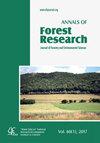The anniversary conference "Structural Components of Forest Ecosystems: ecology, conservation and management" held in honour of Prof. Nicolae Donita
IF 1.7
3区 农林科学
Q2 FORESTRY
引用次数: 0
Abstract
The celebration of the outstanding personalities of academia is always an occasion to exchange ideas, establish the state of art of a scientific area, and highlight the hallmarks and new paradigms. This was the case of the Anniversary Conference "Structural Components of Forest Ecosystems: ecology, conservation and management" held in honour of Prof. Nicolae Doniță, under the generous auspices of the Banat University of Agricultural Sciences and Veterinary Medicine "King Michael I of Romania" in Timișoara. The celebrated scientist, Professor Nicolae Doniță (also member of the Romanian Academy of Agricultural and Forest Sciences “Gheorghe-Ionescu Șișești” and, Doctor Honoris Causa of the Agricultural and Veterinary Sciences University of Banat "King Mihai I of Romania" and of the University Ștefan cel Mare of Suceava) marked in that occasion his 90th anniversary, surrounded by his fellow scientists, former students and collaborators. Fifty-three participants in the conference honoured the personality and lifetime achievements of one of the most prominent figures among the Romanian forest ecologists, who reshaped the fundamentals of the Romanian silviculture based on the ecosystemic approach. The most consistent section of the conference was dedicated to the presentation of oral communications and posters circumscribed to the conference's central theme. The systemic, holistic paradigm adopted in forest ecology was brought forward in the opening lecture given by Prof. Doniță: “On the formation of the forest ecosystem”. The rest of presentations focused on more specific topics or case studies, of which some are briefly mentioned hereinafter. The old-growth forests in Romania were presented from the perspective of significance for the conservation efforts and various hindrances, with special reference to the integration in the larger European concern raised by climatic change and anthropogenic pressures. The forest dynamics in terms of species composition was employed as a tool for the evaluation of forest naturalness in Bosco Quarto (Gargano, Italy). The overview of tropical monospecific forest plantations brought a close insight into an old and controversial problem related to the balance between economic benefits and biodiversity loss. The study of the complex interactions between herbs and tree saplings in southern Appalachian forests revealed the mediator effects of soil fertility and stand evergreenness. The current status of forest habitats in Romania was summarized by means of the second national report to the European Commission (article 17 in the Habitats Directive). The importance of dead wood preserved in situ was demonstrated by the high diversity of saproxylic beetles within the natural reserve Voievodeasa Forest (North-Eastern Romania). The analysis of data contained in management plans was shown to provide useful information for mitigating the consequences of climatic change by improving the ecological status of forests and enhancing their environmental services. The synthesis on the old-growth and virgin beech forests from Carpathians and other European regions, included in the UNESCO World Heritage List, was presented as an important contribution to the forest conservation effort at European level. The role of soil physical and chemical properties, as important determinants for the distinction of forest ecosystem types, was highlighted in the Subsidiary Timiș Forest. The old-growth beech forests included in the nature reserve Izvoarele Nerei (South-Western Romania), famous for its big trees and pristine status, were shown to harbour a high biodiversity encompassing species from different groups. The comparison of two estimation methods of the foliar area index in a beechfir old-growth forest provided interesting insights on the influence of environmental factors. The speakers referred to the scientific stature of Prof. Doniță, but also to his friendly human nature, his talent in gathering people around a common theme, his generous approach to science and scientists, being a leader but not misusing his authority, while always remaining a kind and patient guide. His achievements, spanning across six decades, consist of important international projects, seminal books and a vast array of scientific papers. Several outstanding books he coordinated or co-authored should be mentioned in this context: Forest Ecosystem Types of Romania (1990), Habitats of Romania (2005-2006), Forest Ecology (1978), The Vegetation of Romania (1992), Silviculture on Ecosystemic Bases (1997), The Virgin Forests of Romania (2001), Population, Species, Biocoenosis - An integrating Vision (2019). One of the milestones of Nicolae Doniță’s activity was his participation in the project “Map of the Natural Vegetation of Europe, Scale 1:2500000, with Explanatory Text”, which extended over 20 years of intensive collaboration between experts from across all Europe. Another notable achievement consisted in the elaboration (along with several co-workers) of the Forest Geospatial Database of Romania according to ecosystemic units and the corresponding digital map. In conclusion, the conference gave the rare opportunity of gathering around a hallmark personality of forest ecology and a series of valuable scientific contributions, while celebrating the lifetime achievements of Prof. Doniță in the context of the contemporary forest science. A selection of papers, either presented at the conference or submitted later on, are included in the first section of the current journal issue.为纪念Nicolae Donita教授而举行的“森林生态系统的结构组成部分:生态学、保护和管理”周年大会
学术界杰出人士的庆祝活动始终是交流思想,建立科学领域的艺术状态,突出标志和新范式的机会。在“罗马尼亚国王迈克尔一世”巴纳特农业科学和兽医大学的慷慨赞助下,在Timișoara举行的纪念尼古拉教授Doniță的周年会议“森林生态系统的结构组成部分:生态、保护和管理”就是一个例子。著名科学家Nicolae教授Doniță(也是罗马尼亚农业和森林科学院“george - ionescu Șișești”院士,巴纳特农业和兽医科学大学“罗马尼亚国王米哈伊一世”和苏切瓦大学Ștefan cel Mare的荣誉博士)在他的科学家同行、以前的学生和合作者的包围下庆祝了他的90周年纪念。会议的53名与会者向罗马尼亚森林生态学家中最杰出的人物之一的个人和终身成就表示敬意,他根据生态系统方法重塑了罗马尼亚林业的基本原则。会议最连贯的部分是专门介绍围绕会议中心主题的口头宣传和海报。森林生态学采用的系统的、整体的范式是在Doniță教授的开幕词“论森林生态系统的形成”中提出的。其余的演讲集中在更具体的主题或案例研究上,其中一些将在下文简要提及。从养护努力的意义和各种障碍的角度介绍了罗马尼亚的原始森林,特别提到了气候变化和人为压力所引起的更大的欧洲问题的一体化。利用物种组成方面的森林动态作为评价意大利加尔加诺Bosco Quarto (Gargano, Italy)森林自然度的工具。热带单种人工林的概况使人们对经济效益与生物多样性丧失之间的平衡这一古老而有争议的问题有了更深入的了解。通过对阿巴拉契亚南部森林草本植物与树苗复杂相互作用的研究,揭示了土壤肥力和林分常绿度的中介作用。提交欧洲委员会的第二份国家报告概述了罗马尼亚森林生境的现状(生境指令第17条)。在罗马尼亚东北部的Voievodeasa森林自然保护区,腐木甲虫的高度多样性证明了就地保存的重要性。对管理计划所载数据的分析显示,通过改善森林的生态状况和加强其环境服务,为减轻气候变化的后果提供了有用的资料。关于喀尔巴阡山脉和其他欧洲地区的原始山毛榉森林的综合资料被列入教科文组织世界遗产名录,这是对欧洲一级森林保护工作的重要贡献。土壤物理和化学性质的作用是区分森林生态系统类型的重要决定因素,在蒂米斯特附属森林中得到了强调。包括在自然保护区Izvoarele Nerei(罗马尼亚西南部)的古老山毛榉森林,以其高大的树木和原始的状态而闻名,被证明包含了来自不同群体的高度生物多样性。比较两种估算方法对山毛榉原生林叶面积指数的影响,为研究环境因子的影响提供了有益的启示。发言者提到了Doniță教授的科学地位,但也提到了他友好的人性,他能将人们聚集在一个共同的主题周围,他对科学和科学家的慷慨态度,他是一个领导者,但不滥用他的权威,同时总是保持一个善良和耐心的向导。他的成就跨越六十年,包括重要的国际项目,开创性的书籍和大量的科学论文。在此背景下,应该提到他协调或合作撰写的几本杰出的书籍:罗马尼亚森林生态系统类型(1990年),罗马尼亚栖息地(2005-2006年),森林生态学(1978年),罗马尼亚植被(1992年),生态系统基础上的森林栽培(1997年),罗马尼亚原始森林(2001年),人口,物种,生物群落-整合愿景(2019年)。尼古拉Doniță活动的里程碑之一是他参与了“欧洲自然植被地图,1:25万比例尺,附有说明文字”项目,该项目延续了整个欧洲专家之间20多年的密切合作。 另一项显著成就是(与几位同事一起)根据生态系统单位和相应的数字地图编制了罗马尼亚森林地理空间数据库。最后,会议提供了难得的机会,围绕森林生态学的标志性人物和一系列有价值的科学贡献,同时庆祝Doniță教授在当代森林科学领域的终身成就。精选的论文,无论是在会议上提出的或后来提交的,包括在当前期刊的第一部分。
本文章由计算机程序翻译,如有差异,请以英文原文为准。
求助全文
约1分钟内获得全文
求助全文
来源期刊

Annals of Forest Research
FORESTRY-
CiteScore
2.20
自引率
11.10%
发文量
11
审稿时长
12 weeks
期刊介绍:
Annals of Forest Research is a semestrial open access journal, which publishes research articles, research notes and critical review papers, exclusively in English, on topics dealing with forestry and environmental sciences. The journal promotes high scientific level articles, by following international editorial conventions and by applying a peer-review selection process.
 求助内容:
求助内容: 应助结果提醒方式:
应助结果提醒方式:


